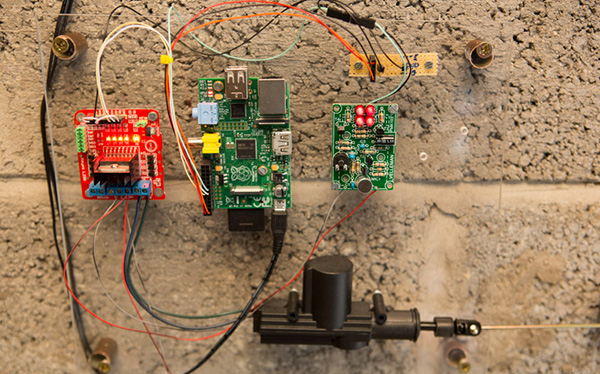It is difficult to understand the needs of your pet while you are sleeping but then they can’t keep quiet.If you are tired with your dog barking timing and want to fix it, then this project by David hunt is for you.This project basically aims at your dog’s need, when they want to go out to pee or come in to sleep. An easy way is to fix the timer switch and a door strike after understanding the patterns of her barking.
But this project is Raspberry Pi oriented and also non-camera related, where the door automatically opens when it hears the bark. It is equipped with noise detector circuit, which is wired to the input of the Raspberry Pi along with the motor driver circuit that makes the actuator to unlock the door with the help of a pulley system.
The audio detection circuit DIY kit took about 30 minutes to assemble but worked perfectly.The LED’s would light up as soon as it hears the bark. Next the audio sensor was attached with a voltmeter to adopt the volume at decent level into the microphone.The GPIO hooked on the Raspberry Pi provides a proper buffer circuit for a logic signal to the GPIO, but he used an actuato, a 12V model,30mm of travel and hence ideal for the lock/unlock mechanism.

A few pieces of metal and an angle bracket, surrounded the concrete blocks attractively to meet the door lock. A couple of bearings was also added to reduce the friction on the mechanism and avoid burning of the actuator. The brains of the project are the Raspberry Pi in the centre and a motor driver PCB to the left. They easily send 12 volts to the actuator in either polarity, for pushing or pulling the door bolt.
The wiring is done with Dupont connectors similar to the Raspberry Pi GPIO header with the help of crimp tool, blank connectors and female crimps. This type of cabling doesn’t require soldering in everything and can easily make a custom connector for the GPIO header.The code for this project is available on the website for reading in the GPIO from the audio circuit.Check out the link for details.
Filed Under: Reviews


Questions related to this article?
👉Ask and discuss on Electro-Tech-Online.com and EDAboard.com forums.
Tell Us What You Think!!
You must be logged in to post a comment.